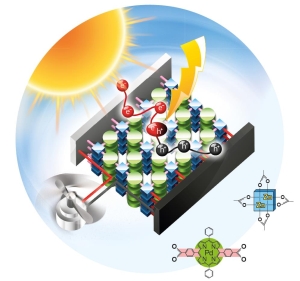Jun 22 2015
Researchers at the Karlsruhe Institute of Technology (KIT) have developed a new material based on porphyrine metal-organic frameworks (MOFs) for photovoltaics. This material is a functioning organic solar cell that is made up of a single component. It demonstrates high elasticity that would enable it to be used for flexible coating of deformable components and clothes.
 Organic solar cells made of metal-organic frameworks are highly efficient in produc-ing charge carriers. (Figure: Wöll/KIT)
Organic solar cells made of metal-organic frameworks are highly efficient in produc-ing charge carriers. (Figure: Wöll/KIT)
“We have opened the door to a new room,” says Professor Christof Wöll, Director of KIT Institute of Functional Interfaces (IFG). “This new application of metal-organic framework compounds is the beginning only. The end of this development line is far from being reached,” the physicist emphasizes.
MOFs are made up of organic molecules and metal node points that assemble and form crystalline, microporous materials. Varying these components can help adjust the material’s functionality, and this property has created wide interest. “A number of properties of the material can be changed,” Wöll explains. Researchers have already developed over 20,000 different types MOFs, which are being used predominantly for gas storage and separation.
In this study, which was led by KIT, porphyrine-based MOFs have been produced. These MOFs demonstrate photophysical properties that are of considerable interest. They demonstrate high mobility, and produce charge carriers with high efficiency. Professor Thomas Heine, and his group from the Jacobs University Bremen, performed computations that revealed that an additional mechanism contributed to the solar cell’s astounding properties. Indirect band gaps were formed that play a critical role in photovoltaics. Porphyrines are found in nature as universal molecules, where organic dyes convert the light into chemical energy. Based on the novel porphyrine-MOF, the research team has developed a metal-organic solar cell.
“The clou is that we just need a single organic molecule in the solar cell,” Wöll says.
The team anticipates that in the future, with further development, the material’s photovoltaic capacity could be increased. The crystalline lattice structure of the material has pores, and filling these pores with molecules that have the capability to take up and also release electric charges would help boost the material’s photovoltaic capacity.
KIT had developed a process through which crystalline frameworks are grown in the form of layers on a conductive carrier surface that is also transparent. This leads to the formation of SURMOFs, which are homogeneous thin films. “The SURMOF process is suited in principle for a continuous manufacturing process and also allows for the coating of larger plastic carrier surfaces,” Wöll says.
MOF thin films possess mechanical properties that enable these thin films with nanoscale thickness to be used for coating deformable components, clothing material and flexible solar cells. Silicon is widely used in systems to convert sunlight into electricity; however, processing of silicon incurs high costs. Hence, organic materials hold promise as an alternative material for silicon in solar cells.
A research paper on this study titled “Photoinduzierte Erzeugung von Ladungsträgern in epitaktischen MOF-Dünnschichten: hohe Leistung aufgrund einer indirekten elekt-ronischen Bandlücke?” (Photo-induced generation of charge carriers in epitactic MOF-thin layers: high efficiency resulting from an indirect electronic band gap?), has been published in the journal Angewandte Chemie International Edition (Applied Chemistry).
Other contributors to this study were, Jinxuan Liu, Jianxi Liu, Goran Kilibarda, Damien Coupry, Satoru Yoneda, Tsuneaki Sakurai, Zhengbang Wang, Engelbert Redel, Wencai Zhou, Ian Howard, Sabine Schlabach, Matthew Addicoat, Yusuke Tsutsui, Shu Seki, and
Peter Lindemann.